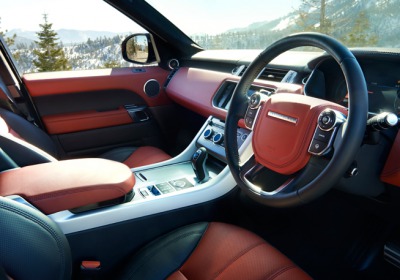Range Rover Sport (2013) first official pictures
Tue, 26 Mar 2013
Here’s the new Range Rover Sport, the third all-new Range Rover to be unveiled in the past 30 months. The design cues stem from the language established by the 2010 Evoque, while the lightweight, all-aluminium architecture is shared with the 2012 Range Rover. The result is a muscular, handsome car which promises to be faster, more frugal and more agile than its hugely successful predecessor. And the breakthrough news this time is that owners will be able to spec a third row of occasional seats, and a four-cylinder engine. Read on to find out more.
Looks good – like a big Evoque…Land Rover chief creative officer (aka design director) Gerry McGovern says his goals were to introduce a greater visual difference with the Range Rover, to improve on the old car’s proportions, and to inject more ‘personality’ into the design. ‘We always have the “revolution or evolution” debate when we replace a model. In my mind, the Sport had to be a revolution,’ says McGovern. ‘It’s sustainable because it’s derived from the Range Rover architecture, but we weren’t constrained by it. The architecture was optimised to get killer proportions and package, and a powerful and athletic-looking car.’
CAR’s first brush with the new Sport was when McGovern had it driven into Land Rover’s outdoor viewing area, and parked up between the current Evoque and Range Rover. Despite its big size, the Sport feels closer in character to the Evoque than the Range Rover, muscular and powerful rather than stately. That’s because the Sport’s key design elements – front grille, glasshouse, rear lamps, side gill –are wider, narrower and work very much in the horizontal plane, whereas the daddy Range Rover’s are more vertical (think of the much taller front grille and rear lamps in particular). Throw in the Sport’s big bazooka tailpipes, ripped surfaces and a supercar-esque, wide front bumper grille, and you have an SUV where the ‘S’ can legitimately stand for ‘sport’.
The first-generation Range Sport was also on hand, to redefine perceptions. I went in musing about how the outgoing car was still a handsome beast (though one with scandalously tight rear passenger space, accessible only to slim and supple gymnasts), and left wincing at its ungainly rear overhang, incorrect position of the rear wheels, and pyramidal top (or “pin-head”, in McGovern speak). Compare the profile views and you’ll spot the key differences: the roofline is now more raked, the beltline spears downwards rather than being horizontal, and the glasshouse is narrower.
What’s beneath this sporty exterior?The Mk2 Sport packs a much leaner chassis, clothed in aluminium panels, or composite in the case of the tailgate. The all-aluminium architecture hacks 420kg off the outgoing V6 diesel’s kerbweight, reducing it to 2115kg. The chassis is so much lighter, Land Rover will be able to plumb in the 240bhp 2.0-litre four-cylinder petrol in 2014, to create a Sport weighing beneath the 2000kg threshold.
Two V6 diesel engines will be offered from launch: the 254bhp TDV6 and 287bhp SDV6. The lower output car takes 7.1sec to reach 60mph from standstill, with the SDV6 shaving 0.3sec off that sprint. Both cars’ CO2 emissions sneak under the 200g/km mark, thanks to the lightweight architecture, stop/start, improved aerodynamics and the latest-generation engines.
Power junkies can opt for the supercharged 5.0-litre V8, which packs 503bhp and blitzes the 0-60mph dash in 5sec flat – almost a second quicker than its predecessor. A 4.4-litre V8 diesel – with 334bhp and 516lb ft of torque – will be added to the range in early 2014, alongside a hybrid which will trim CO2 emissions to 169g/km.
Power is sent to all four wheels via an eight-speed ZF automatic transmission. Punters will have the choice of two four-wheel drive systems: an off-road biased drivetrain with a two-speed transfer box and low range gears, with a 50:50 torque split and 100% locking ability. The other, 18kg lighter system has a more dynamic bias, with the default torque split 42:58 front:rear. This drivetrain employs an electronically controlled Torsen diff, which shuffles torque back and forth, while the electronics vary torque delivery across each axle, braking individual wheels according to grip levels and helping negate understeer in corners.
All Sports have independent suspension, with double wishbones up front and a multi-link rear end. The car is equipped with air suspension, plus continuously variable damping and active roll bars, to tie down the body when you’re going for it. ‘This is the most dynamically capable car we’ve ever made,’ says vehicle line director Nick Rogers. And he should know: he’s worked for the company for 29 years.
What’s it like inside?While the controls and ‘plus sign’-shaped dashboard architecture are familiar from the Range Rover, there are significant changes. The seats are set lower, the central tunnel climbs higher, the dashboard slopes backwards, and the roof lining feels closer, all of which combine to make the cockpit appreciably more sporty. Entry-level Sport models get analogue dials housed in silver-coloured drainpipes, as per the Evoque’s; higher spec Sports have digitised dials on multi-functional TFT screens.
Although the Sport feels snug, pushing the rear wheels back makes the rear seats pleasantly habitable, and sensibly sized rear doors means you can climb aboard too. And while the wheelbase has increased by 178mm, the 4850mm overall length is less than a business card longer than the outgoing car’s. Two forward-facing jump seats can be specified in the boot, and all five rear seats can fold flat at the push of a button to create a decent load bay.
The new Range Rover Sport goes on sale this autumn, with prices starting around £50,000 – ‘not much more expensive’ than the outgoing car.
By Phil McNamara

